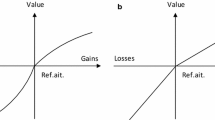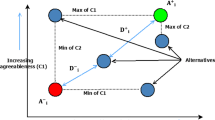Abstract
Mobile healthcare applications are emerging as an innovative and practical technology resource to provide automated and efficient medical services online. However, vagueness and uncertainty commonly exist during the process of selecting doctors online and few studies have addressed these problems. In this paper, we employed interval neutrosophic sets (INSs) to process evaluation information. We proposed and normalized an improved projection measurement for INSs to overcome the shortcomings in extant projection measurements. Additionally, we presented a projection-based difference measure combined with the VlseKriterijumska Optimizacija I Kompromisno Resenje (VIKOR) method to establish a projection-based VIKOR method. Moreover, we introduced transition functions to transform online evaluation information into INSs and employed the maximizing deviation method to obtain weights for criteria. It is a practical problem for patients to choose a suitable doctor on a mobile healthcare application. This problem can be solved by applying the proposed method. Finally, we verified the validity of the method by comparison with several existing methods, and then we conducted sensitivity analysis to demonstrate the method’s reliability. The doctor selection problem can be effectively solved by the projection-based VIKOR method for INSs. Our comparison indicates that the proposed method is more appropriate than other methods, and the final ranking results are more precise than the actual ranking list found online. INSs are effective in describing vagueness and uncertainty in multi-criteria decision-making problems. The method proposed in this paper was viable and valid for use in doctor selection processes with information expressed by INSs.


Similar content being viewed by others
Explore related subjects
Discover the latest articles, news and stories from top researchers in related subjects.References
Meng F, Chen X. Correlation coefficients of hesitant fuzzy sets and their application based on fuzzy measures. Cogn Comput. 2015;7(4):445–63.
Czubenko M, Kowalczuk Z, Ordys A. Autonomous driver based on an intelligent system of decision-making. Cogn Comput. 2015;7(5):569–81.
Cervantes JA, Rodríguez LF, López S, Ramos F, Robles F. Autonomous agents and ethical decision-making. Cogn Comput. 2016;8(2):278–96.
Akusok A, Miche Y, Hegedus J, Rui N, Lendasse A. A two-stage methodology using K-NN and false-positive minimizing ELM for nominal data classification. Cogn Comput. 2014;6(3):1–14.
He Y, Chen H, He Z, Zhou L. Multi-attribute decision making based on neutral averaging operators for intuitionistic fuzzy information. Appl Soft Comput. 2015;27:64–76.
He Y, He Z, Chen H. Intuitionistic fuzzy interaction bonferroni means and its application to multiple attribute decision making. Ieee T Cybernetics. 2016;24(3):558–73.
Kulak O, Goren HG, Supciller AA. A new multi criteria decision making approach for medical imaging systems considering risk factors. Appl Soft Comput. 2015;35:931–41.
Ivlev I, Kneppo P, Bartak M. Multicriteria decision analysis: a multifaceted approach to medical equipment management. Technol Econ Dev. 2014;20(3):576–89.
Ivlev I, Vacek J, Kneppo P. Multi-criteria decision analysis for supporting the selection of medical devices under uncertainty. Eur J Oper Res. 2015;247(1):216–28.
Piegat A, Sałabun W. Comparative analysis of MCDM methods for assessing the severity of chronic liver disease. Lect Notes Comput Sc. 2015;9119:228–38.
Yang J, Gong L, Tang Y, Yan J, He H, Zhang L, et al. An improved SVM-based cognitive diagnosis algorithm for operation states of distribution grid. Cogn Comput. 2015;7(5):1–12.
Baig MM, Gholamhosseini H, Connolly MJ. Mobile healthcare applications: system design review, critical issues and challenges. Australas Phys Eng S. 2015;38(1):23–38.
Pires P, Mendes L, Mendes J, Rodrigues R, Pereira A. Integrated e-healthcare system for elderly support. Cogn Comput. 2016;8(2):1–17.
Gong J, Sun S. Individual doctor recommendation model on medical social network. In: Proceedings of the 7th international conference on advanced data mining and applications, Part II. Beijing, China; 2011. pp. 69–81.
Varshney U. A model for improving quality of decisions in mobile health. Decis Support Syst. 2014;62(2):66–77.
Sandea C, Cadariu AA, Coman I, Drugan T, Ţigan Ş. Multiple criteria decision making in evaluating and ranking medical process models. Appl Med Inform. 2011;20:56–65.
He Y, He Z, Lee DH, Kim KJ, Zhang L, Yang X. Robust fuzzy programming method for MRO problems considering location effect, dispersion effect and model uncertainty. Comput Ind Eng. 2017;105:76–83.
Zadeh LA. Fuzzy sets. Inf Control. 1965;8(3):338–53.
Smarandache F. A unifying field in logics: neutrosophic logic. Mult-Valued Log. 2002;8(3):489–503.
Wang H, Smarandache F, Yanqing Z, Sunderraman R. Single valued neutrosophic sets. Rev Air Force Acad. 2010;17(1):10.
Wang H, Smarandache F, Zhang YQ, Sunderraman R. Interval neutrosophic sets and logic: theory and applications in computing. Arizona: Hexis; 2005.
Ye J. Improved cross entropy measures of single valued neutrosophic sets and interval neutrosophic sets and their multicriteria decision making methods. Cybern Inform Tech. 2015;15(4):13–26.
Ye J. Similarity measures between interval neutrosophic sets and their applications in multicriteria decision-making. J Intell Fuzzy Syst. 2014;26(1):165–72.
Zhang HY, Ji P, Wang JQ, Chen XH. A neutrosophic normal cloud and its application in decision-making. Cogn Comput. 2016;8(4):649–69.
Ye J, Jing F. Multi-period medical diagnosis method using a single valued neutrosophic similarity measure based on tangent function. Comput Meth Prog Bio. 2015;123:142–9.
Tian Z, Zhang H, Wang J, Wang J, Chen X. Multi-criteria decision-making method based on a cross-entropy with interval neutrosophic sets. Int J Syst Sci. 2015;47(15):3598–608.
Ye J. Improved cosine similarity measures of simplified neutrosophic sets for medical diagnoses. Artif Intell Med. 2014;63(3):171–9.
Zhang H, Wang J, Chen X. An outranking approach for multi-criteria decision-making problems with interval-valued neutrosophic sets. Neural Comput Appl. 2016;27(3):615–27.
Zeng S, Baležentis T, Chen J, Luo G. A projection method for multiple attribute group decision making with intuitionistic fuzzy information. Informatica-Lithuan. 2013;24(3):485–503.
Yue Z. An intuitionistic fuzzy projection-based approach for partner selection. Appl Math Model. 2013;37(23):9538–51.
Xu Z, Hu H. Projection models for intuitionistic fuzzy multiple attribute decision making. Int J Info Tech Dec Mak. 2010;09(2):267–80.
Tsao CY, Chen TY. A projection-based compromising method for multiple criteria decision analysis with interval-valued intuitionistic fuzzy information. Appl Soft Comput. 2016;45:207–23.
Ye J. Simplified neutrosophic harmonic averaging projection-based method for multiple attribute decision-making problems. Int J Mach Learn Cyb. 2015; doi:10.1007/s13042-015-0456-0.
Ye J. Bidirectional projection method for multiple attribute group decision making with neutrosophic numbers. Neural Comput Appl. 2015; doi:10.1007/s00521-015-2123-5.
Ji P, Zhang HY, Wang JQ. A projection-based TODIM method under multi-valued neutrosophic environments and its application in personnel selection. Neural Comput Appl. 2016; doi:10.1007/s00521-016-2436-z.
Biswas P, Pramanik S, Giri BC. TOPSIS method for multi-attribute group decision-making under single-valued neutrosophic environment. Neural Comput Appl. 2016;27(3):727–37.
Bausys R, Zavadskas EK, Kaklauskas A. Application of neutrosophic set to multicriteria decision making by COPRAS. Econ. Computat. Econ. Cybern. Stud. Res. 2015;49(2):1–15.
Zavadskas EK, Baušys R, Lazauskas M. Sustainable assessment of alternative sites for the construction of a waste incineration plant by applying WASPAS method with single-valued neutrosophic set. Sustain-Basel. 2015;7(12):15923–36.
Zavadskas EK, Baušys R, Stanujkic D, Magdalinovic-Kalinovic M. Selection of lead-zinc flotation circuit design by applying WASPAS method with single-valued neutrosophic set. Acta Montan Slovaca. 2017;21(2):85–92.
Peng J, Wang J, Yang W. A multi-valued neutrosophic qualitative flexible approach based on likelihood for multi-criteria decision-making problems. Int J Syst Sci. 2016;48(2):425–35.
Sun HX, Yang HX, Wu JZ, Ouyang Y. Interval neutrosophic numbers Choquet integral operator for multi-criteria decision making. J Intell Fuzzy Syst. 2010;28(6):2443–55.
Liu P, Tang G. Multi-criteria group decision-making based on interval neutrosophic uncertain linguistic variables and Choquet integral. Cogn Comput. 2016:1–21.
Opricovic S, Tzeng GH. Extended VIKOR method in comparison with outranking methods. Eur J Oper Res. 2007;178(2):514–29.
Opricovic S. Multicriteria optimization of civil engineering systems. Belgrade: Faculty of Civil Engineering; 1998. p. 5–21.
Dou Y, Zhang P, Jiang J, Yang K, Chen Y. MCDM based on reciprocal judgment matrix: a comparative study of E-VIKOR and E-TOPSIS algorithmic methods with interval numbers. Appl Math Inf Sci. 2014;8(3):1400–11.
Bausys R, Zavadskas EK. Multicriteria decision making approach by VIKOR under interval neutrosophic set environment. Econ Computat Econ Cybern Stud Res. 2015;4:33–48.
Shemshadi A, Shirazi H, Toreihi M, Tarokh MJ. A fuzzy VIKOR method for supplier selection based on entropy measure for objective weighting. Expert Syst Appl. 2011;38(10):12160–7.
Scaramuzzi F, Imbo' M. A multi-criteria intuitionistic fuzzy group decision making method for supplier selection with VIKOR method. Int J Fuzzy Syst Appl. 2012;2(1):1–17.
Chiu WY, Tzeng GH, Li HL. A new hybrid MCDM model combining DANP with VIKOR to improve e-store business. Knowl-Based Syst. 2013;37(2):48–61.
Cristóbal JRS. Multi-criteria decision-making in the selection of a renewable energy project in spain: the Vikor method. Renew Energ. 2011;36(2):498–502.
Xu Z, Da Q. Projection method for uncertain multi-attribute decision making with preference information on alternatives. Int J Info Tech Dec Mak. 2011;3(3):429–34.
Opricovic S, Tzeng GH. Compromise solution by MCDM methods: a comparative analysis of VIKOR and TOPSIS. Eur J Oper Res. 2004;156(2):445–55.
Qin J, Liu X, Pedrycz W. An extended VIKOR method based on prospect theory for multiple attribute decision making under interval type-2 fuzzy environment. Knowl-Based Syst. 2015;86:116–30.
Yue Z, Jia Y. A direct projection-based group decision-making methodology with crisp values and interval data. Soft Comput. 2015; doi:10.1007/s00500-015-1953-5.
Tong LI, Chen CC, Wang CH. Optimization of multi-response processes using the VIKOR method. Int J Adv Manuf Tech. 2007;31(11):1049–57.
Zhang HY, Ji P, Wang JQ, Chen XH. A novel decision support model for satisfactory restaurants utilizing social information: a case study of TripAdvisor.com. Tour Manag. 2017;59:281–97.
Şahin R, Liu P. Maximizing deviation method for neutrosophic multiple attribute decision making with incomplete weight information. Neural Comput Appl. 2016;27(7):2017–29.
Li N, Zhao H. Performance evaluation of eco-industrial thermal power plants by using fuzzy GRA-VIKOR and combination weighting techniques. J Clean Prod. 2016;135:169–83.
Zhu GN, Hu J, Qi J, Gu CC, Peng YH. An integrated AHP and VIKOR for design concept evaluation based on rough number. Adv Eng Inform. 2015;29(3):408–18.
Acknowledgements
This work was supported by the National Natural Science Foundation of China (nos. 71371196 and 71210003). The authors are thankful to the anonymous reviewers and editors for their valuable comments and constructive suggestions that have led to an improved version of this paper.
Author information
Authors and Affiliations
Corresponding author
Ethics declarations
Conflict of Interest
The authors declare that they have no conflict of interest.
Informed Consent
Informed consent was not required as no human or animals were involved.
Human and Animal Rights
This article does not contain any studies with human or animal subjects performed by any of the authors.
Rights and permissions
About this article
Cite this article
Hu, J., Pan, L. & Chen, X. An Interval Neutrosophic Projection-Based VIKOR Method for Selecting Doctors. Cogn Comput 9, 801–816 (2017). https://doi.org/10.1007/s12559-017-9499-8
Received:
Accepted:
Published:
Issue Date:
DOI: https://doi.org/10.1007/s12559-017-9499-8




